At WiseGEEK, we're committed to delivering accurate, trustworthy information. Our expert-authored content is rigorously fact-checked and sourced from credible authorities. Discover how we uphold the highest standards in providing you with reliable knowledge.
What is IV Sedation Dentistry?
While dental patients undergo procedures numbed only by local anesthesia, such as novocaine, others prefer or need to not be aware of what is happening while the dentist is working on them. For these patients, IV sedation dentistry is an option. In IV sedation dentistry, a specially trained dentist both numbs the patient using local anesthetic and administers a sedative drug intravenously. While the patient is actually conscious during the procedure and is capable of responding to verbal commands, he or she is also in a deep state of relaxation, relatively indifferent to the procedure and his or her surroundings. In addition to the relaxation effect, the IV sedation generally produces amnesia in the patient, who is then unable to remember the event. The amnesia can also result in time moving very quickly for the patient.
IV sedation dentistry is typically practiced by dentists who have undergone specialized training in IV sedation. These dentists may also employ a nurse anesthetist or dental anesthetist to help monitor patients under IV sedation. Patents receiving IV sedatives have an IV needle inserted into their hand or arm, and sedative drugs are administered directly into the vein. IV sedation does not always include a painkiller, so the patient will receive local anesthetic either before or after the IV sedation is administered. Because patients can be groggy after receiving IV sedation, many dental offices will insist that the patient be accompanied by a friend or relative who can take them home after their procedure is completed.

Patients choose IV sedation dentistry for a variety of reasons. In some cases, a patient may have an inordinate fear of the dentist or may have had negative experiences with dentists in the past. While many dentists take steps to provide patients with a comfortable, relaxing atmosphere as well as distractions such as music headrests and eye covers, these things may not be enough for an extremely nervous or traumatized patient. A dentist may recommend IV sedation in cases where a procedure is very complex, will take a long time to complete, or if the patient wants to undergo several different procedures at the same time. Other reasons for IV sedation dentistry include a patient's difficulty in getting numb from anesthesia and the needs of children, the mentally ill, or the developmentally disabled, who may find sitting still in a dentists chair for long periods of time to be difficult or impossible.
AS FEATURED ON:
AS FEATURED ON:













Discuss this Article
Post your comments